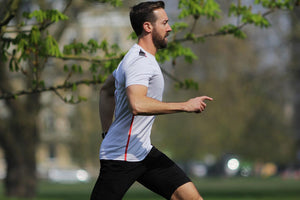
If you’re active in the running community, you’ve probably heard many fellow runners complaining about plantar fasciitis, shin splints, or something about their IT band. But what does it all mean? What are the causes? And, most importantly, what are the preventions and cures?
What is the most common injury in running?
You will have noticed that there are quite a lot of common running injuries. But what is the most common injury in running? We take a look at the top four.
Runner’s knee
Runner’s knee is one of the most common running injuries and is caused by the kneecap (patella) rubbing on the thigh bone and causing irritation. This can be a chronic issue caused by either bio-mechanics or weak quads and tight hamstrings. It is best to treat runner's knee as soon as you notice it by running on softer surfaces such as grass and by including gentle hill work in your runs. Stretch your quads and hamstrings so that they are not tight when you run, and foam roll your calves so that they are released and reduce pressure on the knees.
Plantar fasciitis
Plantar fasciitis is another very common running injury caused by excessive pronation (when your feet roll inwards) and over-straining the feet by running excessively without resting adequately. You will feel heel pain and perhaps pain in the arch of your foot as this is the area affected by this injury. If your trainers are worn out, you will be more prone to developing plantar fasciitis and if you are overweight this will also put strain on this part of the foot. You can prevent or cure plantar fasciitis by making sure you wear shoes that are correct for your physiology and you replace running trainers after 500 miles of use. Read our review of the Asics Phoenix 8 running shoes which are stability trainers for people who overpronate.
IT band syndrome
The illiotibial band, more commonly known as the IT band, is a piece of tissue that runs down the outside of each thigh from the butt to the knee. IT band syndrome is a very common running injury that presents itself as pain on the outside of the knee and the most common cause is weak glute muscles. You can reduce your chances of developing IT band syndrome by doing a runner's strength workout to strengthen your muscles which will in turn stabilise your joints and bones and allow for more balanced movement.
Shin splints
Finally, shin splints are perhaps the most common running injury and presents as a pain in the front of the lower part of the legs. Thankfully, shin splints aren't all that serious, but you should never run through the pain and always listen to your body if it hurts too much to run. Shin splints are thought to be caused by inflammation and swelling of the tissue around the shin bones. This inflammation can be caused by suddenly increasing your activity levels or wearing trainers that don't support you properly. There are easy ways to recover from shin splints, read our in-depth article about shin splints recovery and prevention for more information.

How do you prevent shin splints?
Preventing shin splints is something you will have to make a conscious effort to do as they can strike at any time and can affect most people. To prevent shin splints, make sure you wear trainers that are not worn out and if you overpronate, make sure you find stability trainers that give you enough support.
Related: Adidas stability trainers review
Make sure you stretch and foam roll daily so that your muscles do not stay tight and do not over exert yourself. Do not increase your weekly mileage by more than 10% and keep to a steady pace.

How do runners stay injury free?
The best way to stay injury free is to lead an overall healthy lifestyle. Stretching daily is vital to stay healthy and consider doing yoga or Pilates to stay supple and flexible. Make sure you're eating enough to sustain your training, and make sure you consume enough protein and carbs. Drink plenty of water daily and above all else, take care of yourself! Hot baths will help to relax tired, aching muscles and getting plenty of sleep each night will allow your body to recover fully.





